Digital Foundry vs Super Smash Bros. on Wii U and 3DS
Nintendo's superb brawler assessed on home and handheld platforms.
The hotly anticipated Super Smash Bros. for Wii U joins its 3DS counterpart at last, where a jaw-dropping visual overhaul, plus new control options, stages and modes give the home console a deserved spotlight. Both platforms offer unique tech bullet-points: the Wii U turning in a true 1080p presentation, while the handheld brings an inimitable stereoscopic 3D effect. But with such a wide chasm in core visual setups, are the fundamentals of gameplay at all different between the two - and indeed, does performance hold up for each?
Before we start, the massive elephant in the room here is the disparity in resolutions. To cover off each in turn, we're looking at a native 1920x1080 output on Wii U, a figure even Mario Kart 8 couldn't achieve with its conservative 1280x720. This picture is also kept clear of any manner of anti-aliasing, leaving us with a raw, but pleasingly sharp image at all points. For most titles this would incur a distracting pixel crawl or jagged edges, but due to the fixed, parallel position of the Super Smash Bros. camera, this issue rarely flags up during play.
The game looks gorgeous as a result, but crucially, the 1080p jump also opens up new gameplay avenues on Wii U. For one, it can't be overstated how much this resolution boost aids visibility when compared with Smash Bros. Brawl's 640x480 last-gen output. Characters now appear clearly defined across huge stages, such as fan favourite Hyrule Temple, even when the camera draws back to reveal its entire layout. Where before smash balls and banana peels appeared as specks in the distance, the 1080p image now clarifies every detail.
To capitalise on this breakthrough, co-developers Sora Ltd. and Namco Bandai add even more jumbo-sized stages. The Great Cave Offensive is easily the most elaborate of the bunch - a labyrinth of multiple sections, peppered with girders, lava patches and spike traps - which simply couldn't be carried as effectively on older hardware. And of course, the Wii U's unique eight-player Smash mode fills this space with room to spare.
The 3DS version can hardly compete with Wii U in the image quality department, especially when upscaled to match its proportions. A native 400x240 resolution (or 800x240 output while in 3D mode) is physically the best Nintendo's handheld can muster here. However, it still carries the experience wonderfully for a portable, in part due to some smart design choices. For one, a 2x horizontal anti-aliasing filter is in place when set to 2D mode, adding a half-tone step to reduce jagged edges. It only affects this one axis, while the other is left entirely raw, but it goes some way to softening the blow made by the 3DS' low pixel density.
The added black outlines to characters also serves to bring definition to the action on the 3DS screen - the size of which is another hurdle for gameplay. With a display size of 3.5 or 4.88 inches (depending on your model), the Wii U's gigantic stages are a write-off for the platform, and even its truncated version of Gaur Plains pushes the limits for visibility. To tackle this, director Masahiro Sakurai and his team play to the 3DS' strengths by crafting smaller, exclusive stages like Magicant and Spirit Train - better servicing the handheld with tighter, four-player skirmishes.
Among the few stages shared between Wii U and 3DS, an inevitably stark home console advantage is at play. Geometry across the Gaur Plain, for example, is massively broadened, with platforms also added beneath its two main, arcing ridges. Superficial elements are added too, including denser foliage, while the 3DS's flat skybox is replaced by more polygonal, moving backdrop details. The Wii U even features an event that has one half of the stage levelled, once night-time falls and a mech boss crashes in.
But this is an exception. For other overlapping stages the difference is entirely superficial, as is the case for Battlefield. Based on the same proportions for Wii U and 3DS, geometry across the arena floor is more finessed - but the core of its design remains intact. A superior lighting model on the Wii U is evident too, allowing god rays to stream through trees at dawn break, while physics-based flags flap in the wind to its right side. It's a welcome layer of gloss for the home console, but leaves the building blocks of the stage untouched.
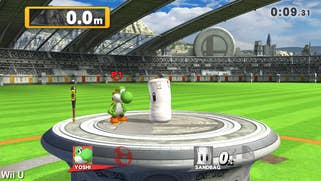
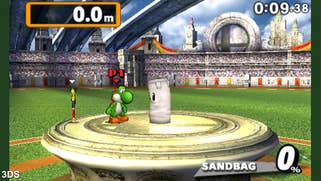
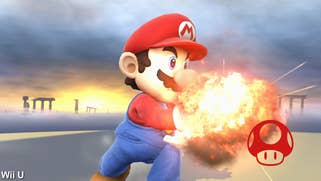

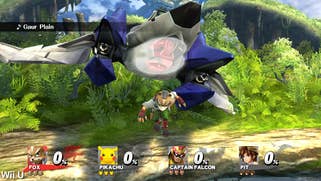



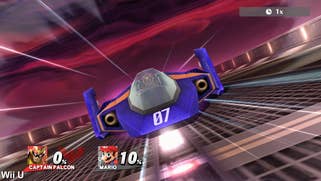
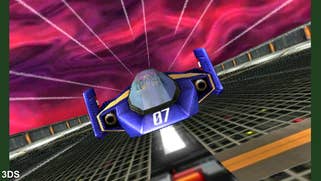

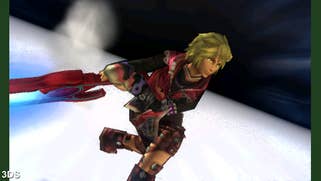
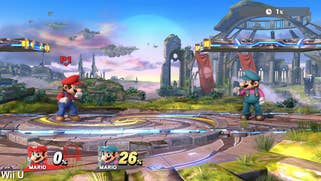
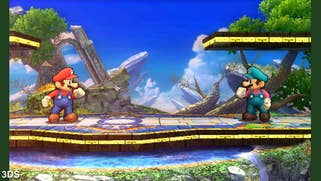


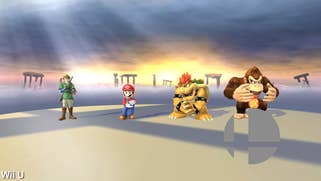

Visual changes between the two are many, but what's remarkable is just what remains the same. In pairing shots for our head-to-head video, animation frame data for each character is almost entirely identical between platforms. From the range of Little Mac's charged punch to the duration of Link's upward smash, every move on 3DS locks to the Wii U timings - making it a handy companion for those practicing on the go.
There are exceptions, we notice, such as the slight lengthening to the cool-down on Zero Suit Samus' side smash on Wii U. However, where most moves translate directly from handheld to the big screen, this close pairing only highlights a drastic upgrade to character rigging on Wii U. Alongside the bumped clothing detail for characters like Shulk, sharp polygonal corners are rounded. Up-close during victory poses, this noticeably gives way to more complex jaw structures on character's like Fox, and also a curl to Donkey Kong's fingers.
For the most part, it's the stylisation of Smash moves that stands out. Alpha effect quality sky-rockets on Nintendo's home platform, for example, as seen across lobbed Bob-ombs or Mario's fireball attacks. This ranks among many cutbacks on the handheld version that is happily overlooked, however, as it's only in blowing the 3DS' image up that these shortcomings really detract. For its screen size, the handheld's graphical setup is otherwise very well suited.
To the Wii U's credit though, extra effort is made to introduce lighting properties into the mix, with explosions illuminating nearby stage and characters - not seen on 3DS. Shadows are also given an overhaul. Characters now produce detailed, long shadows based on the sun's position, whereas the 3DS resorts to a simple spot shadow at each character's feet. Curiously, the handheld renders rough silhouettes behind characters on the victory screen - but nowhere else.
When it comes to frame-rate metrics, Nintendo's record is very sturdy in recent efforts like Super Mario 3D World and Mario Kart 8. And in line with Smash Bros. series tradition, both 3DS and Wii U confidently strike the 60fps target with full v-sync engaged. As a general rule, both hold to this grade of performance near perfectly in most instances.
For the home console release, we do see minor hiccups that bear passing mention. These are plucked from a range of scenarios, such as the crashing of a metal rig above the Boxing Ring stage, initiating a final smash move, and also landing a knockout blow. Barring the first, the resulting blips are rarely consequential to the flow of play. In fact, even eight player matches throw up little the Wii U can't resolve at a full 60fps update - only taking the faintest dip to 58fps in our tests on claiming a smash ball.
Given it's a full 1080p title as well, all signs point to a very well optimised Wii U rendition, with just a few rough edges. Performance on 3DS is less robust meanwhile, but still impressive. A 60fps line is held almost to a tee, but with odd, single frames dropping throughout battles on Final Destination and Battlefield stages. Thankfully, this still gives it the perceptual effect of 60fps, where the screen's smaller size makes it easier to miss these occasional, missed frames.
Nintendo's handheld also has issues with heavy build-ups of alpha effects - though final smashes are tightly optimised. Case in point: a 54fps drop is recorded for one fiery finishing move on the Yellow Devil boss, while Fox's final Smash barely makes a dent. The frequency of such frame-rate hits is controlled, however, with the 3DS reducing its item drop rate to match the Wii U's lower settings. On balance, it makes these lurches unusual, but puts a ceiling on the chaos that might emerge during frenzied four player bouts.
Super Smash Bros. for 3DS and Wii U - the Digital Foundry verdict
Call it the Nintendo touch - the fourth entry in the Smash Bros. series is a true technical milestone for both of the Kyoto giant's leading platforms. It's all too easy to pluck a winner from the two when placed side-by-side, of course, especially in blowing the handheld version up to matching scale. Rather, it instead magnifies our respect for co-developers Sora Ltd. and Bandai Namco, whose agenda is clearly set on extracting the best from 3DS and Wii U hardware.
Even with visual cutbacks, the 3DS produces a beautiful, fully stereoscopic 3D rendition of the game at a near perfect 60fps - an impressive feat for a handheld. The level selection, most of which is unique to the platform, is also crafted around the smaller screen size. Skyboxes are drawn closer, textures are enlarged to improve visibility, the colour palette is exaggerated, and characters are even given an (optional) black outline to help players keep track of the action.
At its heart, and despite using two very different tiers of polygonal detail, the 3DS and Wii U also share the exact same animation frame data for each character. The Wii U no doubt offers the premium visual set though, and eight player stages like The Great Cave Offensive thrive on its ability to output at a native 1920x1080. A slew of other visual upgrades are also brought to light at this resolution - including an enhanced lighting model, dynamic shadows, upgraded texture maps and even reworked stage backgrounds.
Whether or not this is the definitive release for the competitive scene, its technical faculties have to be admired. Smash Bros. on 3DS and Wii U is a labour of love from Sakurai and his team, realising characters from all corners of the industry at previously unseen levels of detail. Presented with stereoscopic 3D in your hands, or at a crisp 1080p for couch play, it's a success for Nintendo fans of either persuasion.




